Intel Roadmap Leaks: Raptor Lake Refresh, HEDT Replacement in 2023
Intel's 2023 desktop roadmap is reportedly detailed.
Intel plans to make an important disclosure about its client PC platform roadmap next week, but some parts of the presentation have already been leaked by HXL (@9550pro). In fact, for performance PC enthusiasts, Intel's Desktop and Workstation Platforms Roadmap that covers things like Raptor Lake-S Refresh processors for 2023 desktops as well as Sapphire Rapids-64L/112L CPUs set to address high-end desktops and workstations next quarter poses even more interest.
Raptor Lake-S Refresh: Coming in 2023
One of the biggest surprises revealed by the leaked document is that Intel plans to retain its Raptor Lake processors for desktops for another year. Set to arrive in Q3 2023, Raptor Lake-S Refresh CPUs will continue to serve entry-level workstations and desktops for enthusiasts, mainstream users, and commercial desktop PCs.
The leaked roadmap does not reveal any specifications or improvements of the Raptor Lake Refresh processors over existing products, but typically refreshes increased clocks and sometimes features some minor improvements like enhanced power delivery or different turbo boost algorithms. The excerpts from the document also do not disclose whether Intel's 34-core Raptor Lake-S (RPLS-34C) is a part of the RPL Refresh family, but something tells us that this piece of silicon is reserved for workstations.

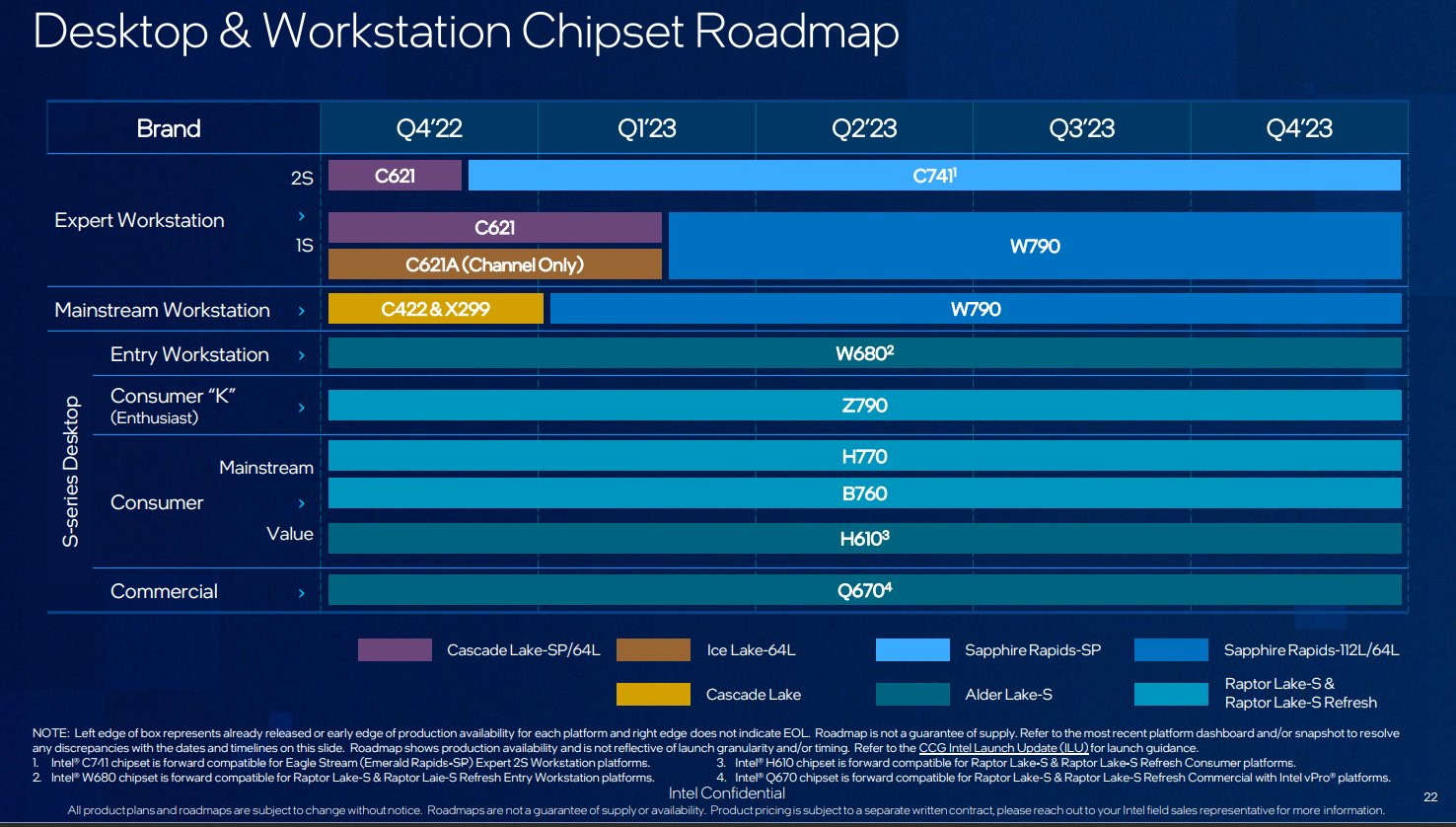
What does strike the eye about Intel's plans for desktops in the second half of 2023 is the lack of its codenamed Meteor Lake processor that will rely on a multi-tile (multi-chiplet) design. Perhaps, this part is reserved for mobile platforms only or will arrive at desktops sometime in 2024.
Intel's Raptor Lake-S Refresh will continue to rely on Z790, W680, Q670, and various 700-series chipsets. However, we do not have information on whether these new parts will be drop-in compatible with existing motherboards (including those powered by 600-series chipsets).
Sapphire Rapids-64L and Sapphire Rapids-112L: Xeon W-2400 and Xeon W-3400
Intel has not updated its workstation and high-end desktop platforms for about three years now, and today its CPUs released in Q4 2019 – Q1 2020 (and based on the Skylake microarchitecture from 2015) look rather pale, to put it mildly. For those who want a high-end CPU from Intel, the new desktop platform roadmap brings good and bad news.
The good one is that the company plans to introduce its Xeon W-2400 (Sapphire Rapids-64L) and Xeon W-3400 (Sapphire Rapids-112L) offerings for desktop workstations in Q1 2023. The bad news is that Intel essentially abandons its HEDT product lineup and will address this market with Xeon-branded offerings and platforms.
Get Tom's Hardware's best news and in-depth reviews, straight to your inbox.
As revealed a week ago, both Xeon W-2400 and Xeon W-3400-series processors will come in LGA4677 packaging and use motherboards based on the Intel W790 chipset.
As far as CPU features are concerned, Intel's Xeon W-2400 will offer up to 24 high-performance cores, 64 PCIe 5.0 lanes, a quad-channel DDR5 memory subsystem supporting up to 2TB of DDR5 memory with ECC, as well as processor base power (PBP) of up 225W. By contrast, Intel's Xeon W-3400 processors will come with up to 56 high-performance cores, 112 PCIe 5.0 lanes, an octa-channel DDR5 memory subsystem supporting up to 4TB of ECC memory, and a PBP of up to 350W.
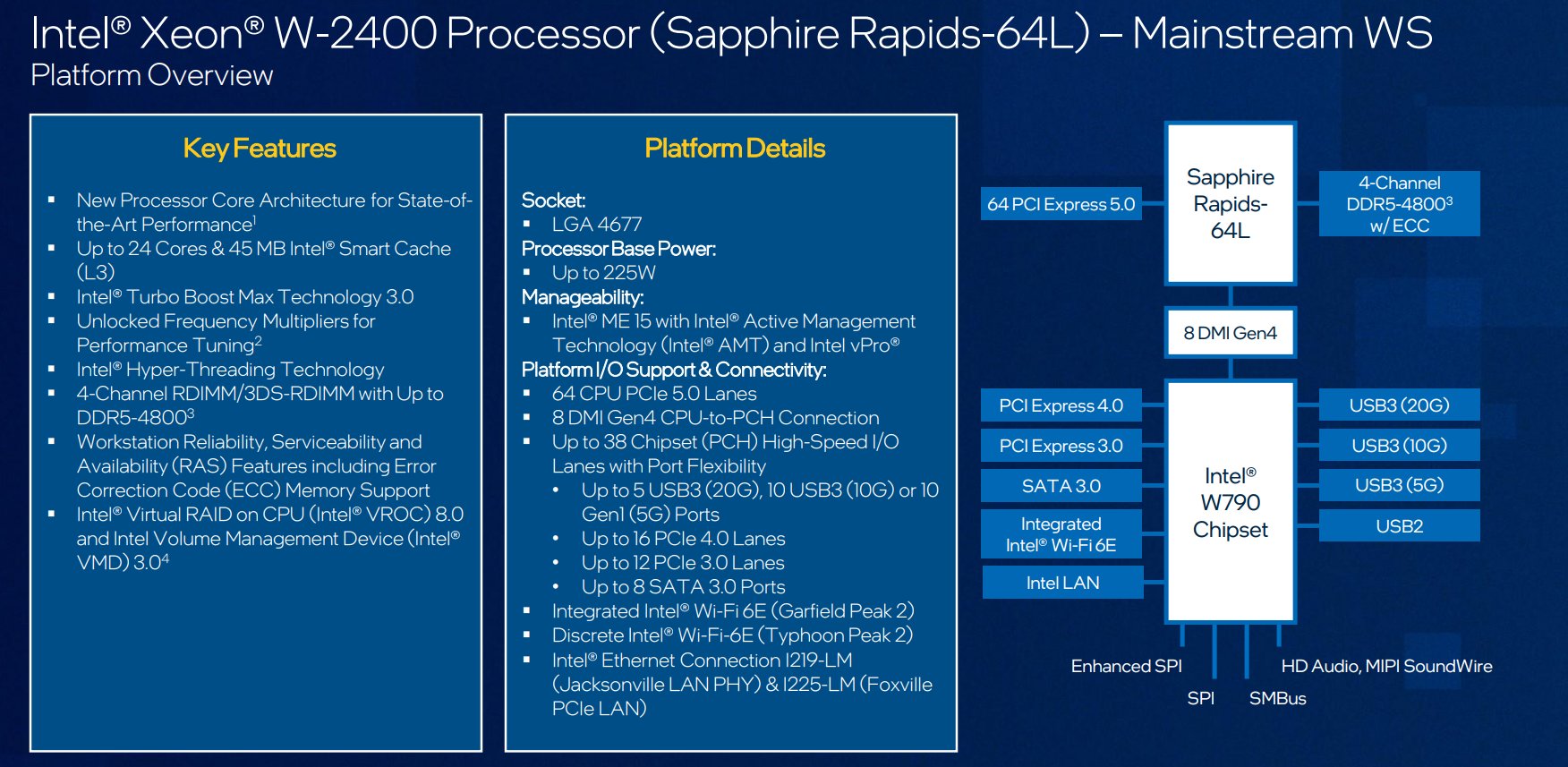

As for frequencies, the base clocks of all Sapphire Rapids-WS CPUs are pretty low (from 1.90 GHz to 3.20 GHz, depending on the SKU), but Turbo frequencies exceed 4 GHz in most cases. Actual clocks will rely on cooling systems and power limits, so we will see how fast these CPUs are in real life. Many of the Xeon W-2400/W-3400 models will come with an unlocked multiplier and overclockable, so those who want to push these processors to their limits will have such an opportunity. Meanwhile, it does not look like memory will be overclockable (not that one needs it with a quad or eight-channel DDR5 memory subsystem).
Since we are talking about Xeons, these W-2400/W-3400 processors will support all the workstation-grade reliability, availability, and serviceability (RAS) features as well as capabilities like Virtual RAID on CPU (VROC) 8.0 and Intel Volume Management Device (VMD) 3.04.


In addition to increased core count, all-new CPU microarchitecture, PCIe Gen5, and DDR5 support, the new workstation platform from Intel will feature relatively comprehensive and up-to-date I/O capabilities courtesy of the W790 chipset. The new W790 core logic will provide up to 16 PCle 4.0 lanes, up to 12 PCle 3.0 lanes, up eight SATA ports, up to five USB 3.2 Gen2x2 connections, and up to 10 USB 3.2 Gen2 ports. The chip will also integrate Wi-Fi 6E capabilities and support two 2.5GbE PHY controllers. Furthermore, as the W790 is designed for desktop PCs, it will come with HD Audio, MIPI SoundWare, and other features for client PCs.
The W790 chipset does not support PCIe 5.0, Thunderbolt 3/4, or USB 4/4.1, which is a pity. But keeping in mind that it connects to its host CPU with eight DMI Gen4 lanes, this might be a logical move to ensure maximum I/O performance as the chipset already packs quite a bit of bandwidth-hungry interfaces.
Sapphire Rapids-SP: Xeon Scalable on C741
For those who need unbeatable performance, Intel will offer to use its Eagle Stream platform, supporting up to two server-grade 4th Generation Xeon Scalable Platinum, Gold, Silver, or Bronze (Sapphire Rapids-SP) processors. When equipped with two CPUs, the platform will provide up to 112 high-performance cores with Hyper-Threading, 160 PCIe Gen5 lanes, and up to 8TB of 16-channel DDR5 memory per box. In addition, of course, this platform will offer all the RAS and remote management capabilities in the Sapphire Rapids-WS but will naturally not offer any overclocking features.
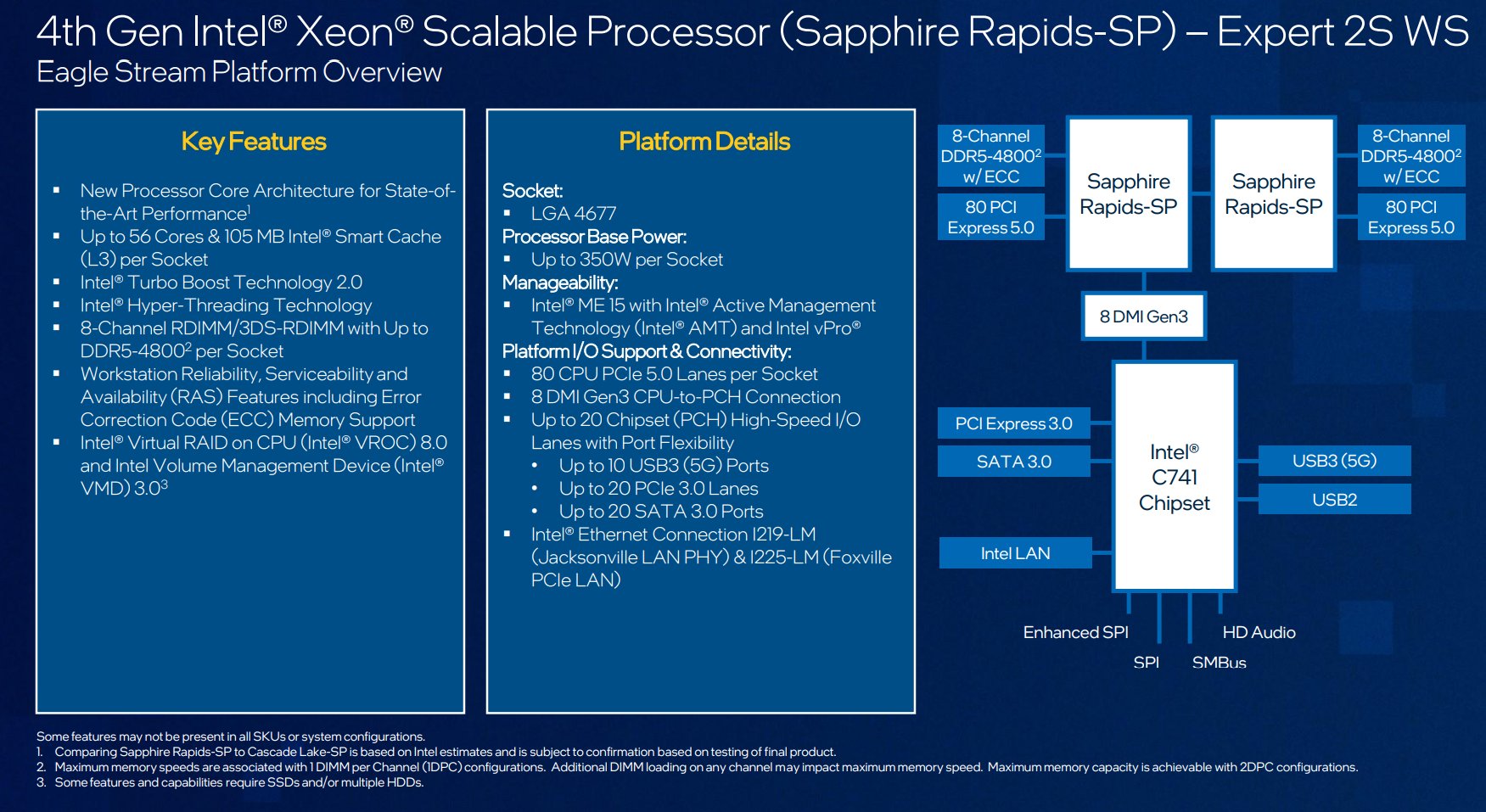
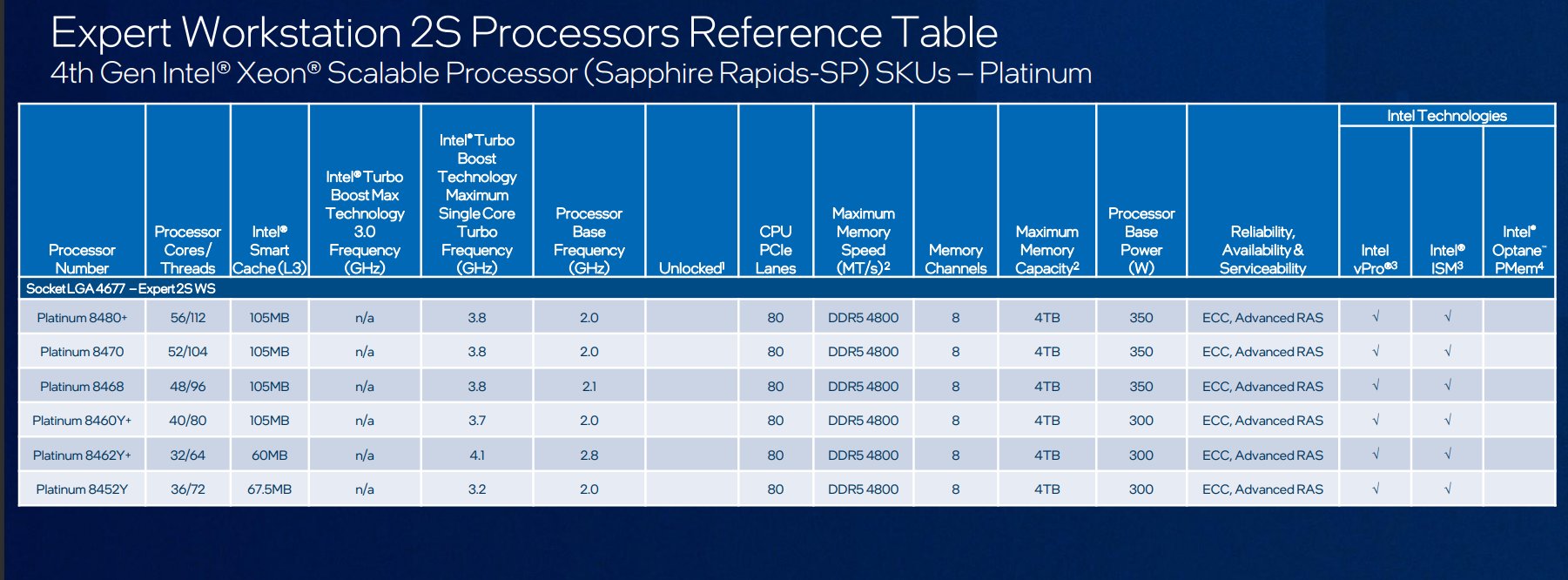

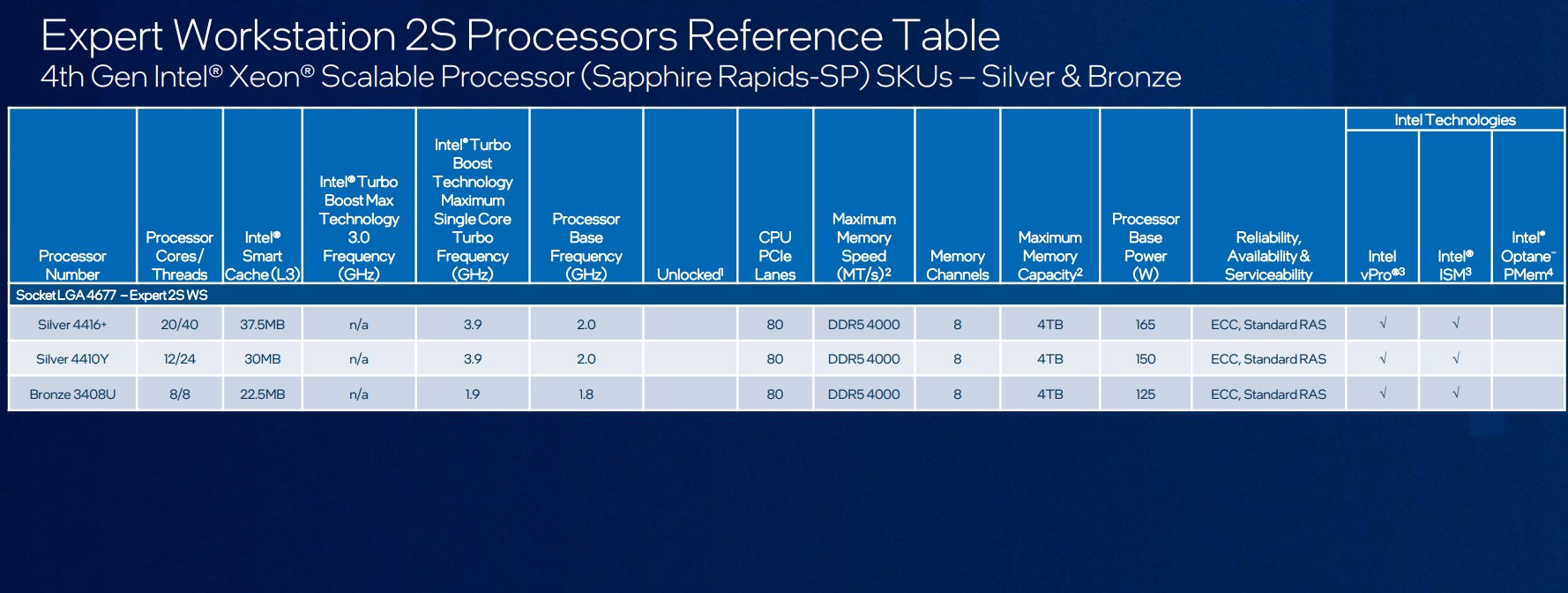
While Eagle Stream workstations will offer unbeatable number-crunching capabilities, they will rely on the server-grade C741 chipset that does not support modern I/O capabilities. Workstation makers like Dell and Lenovo will equip Sapphire Rapids-SP-based machines with a bunch of extra controllers to make up for a modest chipsets, of course, so this might not be a problem for those who get complete boxes.
More Details About Client PC Platforms to Come
While the desktop part of Intel's plans for 2023 is more or less clear, there are several things that the company will address at its upcoming event for investors. In addition to Meteor Lake, Arrow Lake, and Lunar Lake CPUs coming in the next few years, Intel will likely talk about its plans for discrete graphics, next-generation Thunderbolt based on USB 4.1, Wi-Fi 7, and a bunch of other things that are set to make its platforms more appealing than those of its rivals. So, stay tuned.

Anton Shilov is a contributing writer at Tom’s Hardware. Over the past couple of decades, he has covered everything from CPUs and GPUs to supercomputers and from modern process technologies and latest fab tools to high-tech industry trends.
-
STOP The Song & Dance A leak or the start of a planned flood. Every where we go, we hear of a leak here and a leak there, it's like the watergate scandal. New product leaks are normal, my cup has been filled to the brim one drop at a time. Is it news or just advertising. Sorry, I am not picking on INTEL, they are doing the picking. This is not a leak, but the way it is.Reply -
bit_user This told me what I needed to know, which is that the W680 will not be replaced. That's a little unfortunate, but at least I don't have to wait for another generation of motherboards to launch.Reply
Now, there's just the issue of ECC DDR5 UDIMMs: price & availability. ...or, I guess that's backwards, as you have to be able to find it in stock, before you can even think about pricing. -
bit_user Reply
Obviously, we'll have to wait and see, but I wouldn't count Raptor Lake R as a separate CPU generation. It's more likely to be like Haswell R, than Coffee Lake R.rtoaht said:Looks like Alder lake motherboard will be supported for 3 generations. -
-Fran- Reply
Is it me or they're looking to compete with AMD's upper workstation class instead of bringing back "the middle-ground"?bit_user said:This told me what I needed to know, which is that the W680 will not be replaced. That's a little unfortunate, but at least I don't have to wait for another generation of motherboards to launch.
Now, there's just the issue of ECC DDR5 UDIMMs: price & availability. ...or, I guess that's backwards, as you have to be able to find it in stock, before you can even think about pricing.
Still, even if they're able to put just a tiny bit of pressure on AMD, they may lower prices? Maybe?
Regards. -
jp7189 A workstation CPU with 350W base power?! What's the turbo power on something like that? ADL/RPL can easily double their base if allowed.Reply -
TJ Hooker A little surprised that Intel's first desktop chips based on Intel 4 (meteor lake-S) are seemingly delayed, despite them bragging only a few days ago about Intel 4 being ready and on track for high volume in 2023.Reply -
truerock ReplyAdmin said:Intel's Raptor Lake to stay for long as Intel kisses goodbye to the HEDT platform.
Intel Roadmap Leaks: Raptor Lake Refresh, HEDT Replacement in 2023 : Read more
This does not surprise me.
There were rumors that Meteor Lake would have 6-power-cores which is less than Raptor Lake's 8-power-cores.
There were definitely some issues going on with Meteor Lake.
I'm guessing Intel decided to skip the 6-power-cores Meteor Lake in 2023 and start with an 8-power-cores Meteor Lake in 2024.
So, what is the deal? Is there some problem with getting 8-power-cores on Meteor Lake?
Maybe there was a heat/thermal issue with the new smaller cores being close together?
Also, maybe the issue of efficiency-cores for desktop PCs will finally just go away?
Sure, efficiency-cores are needed on smart phones where battery power is a primary issue. Even some categories of notebook computers take battery power as a primary design issue.
E-cores and integrated-graphics on a CPU chip for desktop PCs is not a particularly logical thing (except for very low-end desktop PCs which can be built with notebook PC tech).
High-power RISC cores to complement high-power complex CPU cores might be advantages for desktop PCs.
Low-power, energy-efficient cores only make since for mobile computing using battery power. -
bit_user Reply
Meteor Lake is their first mass market tile-based CPU. Could be something to do with that?truerock said:So, what is the deal? Is there some problem with getting 8-power-cores on Meteor Lake?
Not a chance.truerock said:Also, maybe the issue of efficiency-cores for desktop PCs will finally just go away?
E-cores aren't only about power-efficiency (which, don't kid yourself, is definitely a limiting factor for desktop), but also area-efficiency. And perf/mm^2 also determines perf/$. So, there's not a chance Intel is going to withdraw hybrid CPUs from the desktop.truerock said:E-cores and integrated-graphics on a CPU chip for desktop PCs is not a particularly logical thing (except for very low-end desktop PCs which can be built with notebook PC tech).
The way I read their decision to reduce the P-cores of Meteor Lake is that the next-gen P-cores are probably a lot bigger and the future E-cores are probably even closer in performance to the P-cores. If the E-cores are fast enough, then you only need enough P-cores to get good performance on lightly-threaded workloads. For everything else, a sea of E-cores would be the main horsepower of the CPU. -
hotaru251 Only good thing I'd want out of an INTEL HEDT....is AMD to compete at it and re-release non pro TR again.Reply
